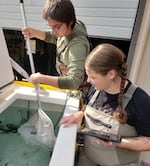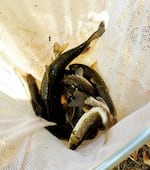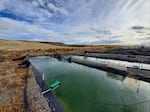
Jazzy Jackson, left, and another fish technician release C'waam and Koptu, also known as Lost River and shortnose suckers, into the Sprague River.
Juliet Grable / JPR
It takes a village to raise suckerfish, and the Klamath Tribes are growing hundreds of the bottom-dwelling species in constructed ponds near Chiloquin of Southern Oregon. On a bright October morning, a crew has gathered to return a small number of them to the Sprague River, a tributary of Upper Klamath Lake.
Two technicians take turns transferring netfuls of fish from kiddie pool-sized holding tanks to a waiting truck. Klamath Tribes Fisheries Technician Charlie Wright sits perched next to the tank, verifying that each fish has been fitted with a passive integrated transponder, or PIT tag, which allows biologists to track where they go and how well they survive.
“We’re scanning them as we’re loading them to make sure everybody has a tag because we can’t release anybody without a tag,” says Wright.
Two species of fish are going into the tank: Koptu and C’waam, aka shortnose and Lost River suckers. The fish range in age and size, but all have reached a critical threshold, measuring at least 200 millimeters — about eight inches — from head to tail.
“We’re hoping for a pretty good survival rate,” says Wright. “We actually have quite a few sexually mature fish in here, which is really exciting to release because next spring they’ll be able to make babies if they’re comfortable enough.”

Klamath Tribes Fisheries Technicians Jazzy Jackson and Charlie Wright, right, transfer C'waam and Koptu at the Tribes' Ambodat fish rearing facility.
Juliet Grable / JPR
C’waam and Koptu are essential “first foods” intertwined with the Klamath Tribes’ culture and identity. Both species live only in the Upper Klamath Basin, primarily in Upper Klamath Lake. Chronically poor water quality has made the lake lethal for young fish. As a consequence, most suckers that are alive today are geriatric, and both species are endangered. Fewer than 5,000 individual Koptu remain.
Related: C’waam and Koptu: The fish at the center of the Klamath Basin’s water crisis
For this reason, both the U.S. Fish and Wildlife Service and the Klamath Tribes have been capturing wild larvae and rearing suckers in specially constructed ponds. The ponds at the Tribes’ Ambodat facility — the name means “of the water” in the Klamath language — are designed as healthier microcosms of Upper Klamath Lake, with the right balance of bugs, water chemistry, and nutrients, but where fish can grow safe from predation and poor water quality — the bigger, the better. Larger fish can more easily evade predation, and they are less vulnerable to the oxygen-starved conditions that develop in Upper Klamath Lake every summer.
“We’re hoping to get them past that bottleneck, and hopefully get recruitment back into the population,” says Brad Parrish, water rights specialist for the Klamath Tribes.
On this day, they plan to release 117 suckers into the Sprague River near the high school in Chiloquin. It’s a modest number, but if even some of them survive long enough to reproduce, the effort will have been worth it to the Tribes.

Juvenile C'waam and Koptu being transferred at the Klamath Tribes' Ambodat fish rearing facility.
Juliet Grable / JPR
A stop-gap solution
Suckers are long-lived fish: an adult C’waam can exceed 10 pounds and live for half a century. They look almost comical, with their fleshy, protruding lips, but their specialized mouths serve a purpose, as mature fish spend most of their time near the bottom of the lake, feeding on invertebrates. They move to cold springs on the lake’s fringes or nudge up into the tributaries to spawn. Once the larvae develop, they start moving out into the lake themselves. That’s where the challenges begin for young suckers.
Large, warm, and shallow, Upper Klamath Lake has always been high in nutrients, thanks to the naturally occurring phosphorus in the region’s volcanic soils. But, a cascade of changes over the last 100 years, most related to the conversion of land for farming and ranching, has tipped the balance. Nearly all of the wetlands around the lake edge were drained, which not only stripped away the lake’s natural filters but also the places where young suckers can seek refuge from birds and other predators. Diking and straightening have turned upstream tributaries into chutes that deliver nutrient-laden sediment into the lake. Algae devour those nutrients; the blooms consume oxygen, leaving little for other aquatic creatures. While all fish suffer, young fish are the most vulnerable.
Related: Klamath Tribes sue federal government over endangered fish
Drought and water allocations for farming have added to the problem, especially when lake levels dip so low that adult suckers can’t access their spawning grounds.
By the mid-1980s, sucker numbers had declined so much that the Tribes’ game commission declared a moratorium on harvesting; both species were listed as endangered under the federal Endangered Species Act in 1988. The last major spawning event occurred in the early 1990s, which means that most of the suckers alive today are nearing the end of their lives.
Now, saving the suckers is an all-hands-on-deck effort, with the U.S. Fish and Wildlife Service, U.S. Geological Survey, U.S. Bureau of Reclamation and private landowners playing a role.
Related: Endangered fish and waterfowl find refuge at the Klamath Basin’s Lakeside Farms
The U.S. Fish and Wildlife Service launched its sucker rearing program in 2013; since 2018, the agency has released just over 70,000 suckers into Upper Klamath Lake. Right now, the agency is constructing a new, larger rearing facility with the aim of releasing up to 60,000 fish each year.

U.S. Fish and Wildlife Service rears suckers at the Klamath Falls National Fish Hatchery near Upper Klamath Lake.
Courtesy of U.S. Fish and Wildlife
“We share staff between our hatchery and the Tribal hatchery, and they’ve come back our way and helped us out with knowledge, staff and materials,” says Josh Gondek, fish biologist for U.S. Fish and Wildlife Service’s Sucker Assisted Rearing Program. “A lot happens to get these fish raised to two to three years old.”
The Klamath Tribes released around 400 suckers in 2021 and approximately 700 in 2022. Now, they plan to ramp up their rearing program more than tenfold. To support their goal of releasing 10,000 fish every year, they’ve hired aquaculturist Carlie Sharpes and are building additional ponds at the Ambodat facility. Eventually, they plan to raise spring Chinook here, too, as part of the plan to reintroduce the salmon to the upper basin once four dams on the Klamath River are fully removed next year.
Ultimately, the best way to help C’waam and Koptu is large-scale restoration of wetlands, rivers and forests, a task the Tribes, U.S. Fish and Wildlife Service and their partners are prioritizing, with the help of a basin-wide integrated plan released earlier this year. Until then, the rearing program is a stop-gap measure to keep the suckers from going extinct.
“Hopefully one day this won’t be necessary, because we’ll have the habitat in a restored state where the fish won’t need to be artificially reared,” says Sharpes. “At a certain point, we can’t just create new technologies to slap a Band-Aid on the problem.”
Related: Hatcheries may be the last best hope for endangered sucker fish in the Klamath Basin
Looking at the whole system
Hog Creek Ranch is 20 miles northeast of Chiloquin and the Ambodat facility, down a stretch of lonely red-dirt forest road lined with ponderosa pines. Hog Creek, a tributary of the Williamson River, runs through the ranch, although there’s no sign of it in late October. Parrish remembers wandering onto this land decades ago as a teenager, while hunting.
“There was water flowing through here and there was fish in here,” he says. “This was a wetland at one point. Now you can still see some of the wetland vegetation in certain locations, but a lot of its grass.”
A previous landowner diverted the creek into a straight ditch and likely drained the wetland so they could graze cows in the meadow. Logging hammered the forest, and a railway, built to carry timber out of the valley, cut a natural spring off from the meadow.
Right now, melting snow shoots down the straightened section of Hog Creek, carrying sediment with it. The degradation that’s happened in this meadow is a case study for the entire basin.
“This has turned into a really flashy system, where everything’s gone as soon as we get snow out,” says Parrish. Instead of storing water like a sponge, the upper basin acts like a sieve, with water flowing swiftly through upper tributaries and into the lake and down the Klamath River. By summer, even in decent water years, there’s not enough water for all of the tribes, farmers, fish, and birds that depend on it.

Klamath Tribes Water Rights Specialist Brad Parrish stands at Hog Creek Ranch, where he is leading a creek restoration project.
Juliet Grable / JPR
Wet meadows high in the watershed such as the one on Hog Creek could and should serve as natural storage reservoirs that slowly release water through the summer. Restoring this function, Parrish believes, is key to addressing two of the upper basin’s biggest challenges: water scarcity and water quality. The Klamath Tribes recently purchased the 1,200-acre ranch with the express aim of restoring both its meadows and forests.
This fall, Parrish’s crew began removing the conifers from the meadow edges, which they will chip or burn in place. Next, they filled in the straightened, artificial ditch. Now they’re coaxing the creek back into its historic, meandering channel and installing structures made from rock and wood posts to slow the creek down. Arrow-shaped “cross-vanes” force water to either side, where it must travel slightly upslope. “J-hooks” essentially do the same thing but are built at stream bends.
Related: 5 things to know about the Klamath water crisis
Both types of structures are designed to catch sediment, says Parrish. “I want to capture whatever sediment is coming into the system, because that is an issue when we’re talking about water quality within the lake.”
The meandering creek channel will spill over onto the surrounding floodplain and encourage willows to establish. Before long, the meadow will maintain itself. Soon, a crew will start working to restore the forest above the meadow, too.
“What I hope to show is that by addressing not only these “sponges,” — these wetland areas — but the upland forest, you could then have a constant input (of water) into the system,” says Parrish, who is involved in the planning process for annual water allocation for the basin. “It’s all important, and we have to look at it from that perspective, or we’re just going to continue to fight and we’re not going to get anywhere.”

A "cross vane" structure being used as part of a creek restoration project at Hog Creek, a tributary of the Williamson River.
Juliet Grable / JPR
Praying for survival
Later that October morning, the Ambodat crew travels with their precious cargo of suckers to a spot where the Sprague River flows behind the high school in Chiloquin. The crew of a dozen people transfers the fish by net, a few at a time, until all 117 are in the river. Each one has been fitted with a PIT tag and will become part of the larger database of basin-wide sucker monitoring. The release is one of several planned this fall.
Historically, C’waam and Koptu were the first fish back in spring — a welcome sight for Klamath people after a long winter subsisting on stored dried foods. Following close behind the suckers were healthy runs of salmon and steelhead — an abundance younger generations can hardly imagine.
Natalie Ball, a member of the Klamath Tribes who serves on the tribal council, has walked down to the river with her 11-year-old son to watch the release. Ball joined the tribal council in part because she saw the precipitous decline of these fish, and a third species of sucker, and wanted to be part of a collaborative body that made decisions on their behalf.
“I pray for our C’waam and our Koptu and our Yen, and I want my son to remember who we’re praying for,” says Ball. “It’s a moment to honor and respect our fish relatives, and to pray for them for their survival.”